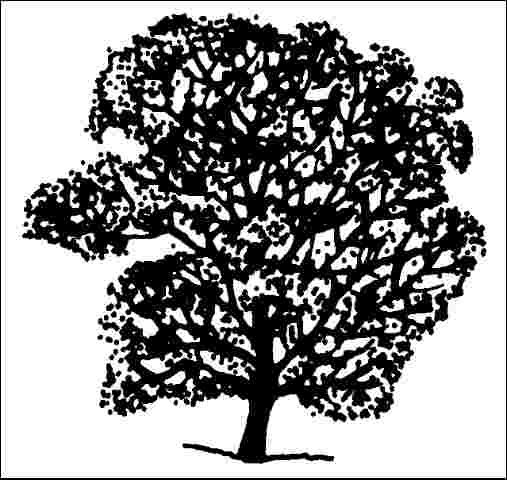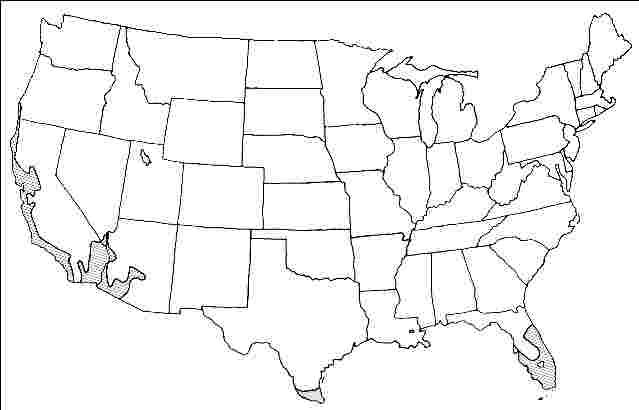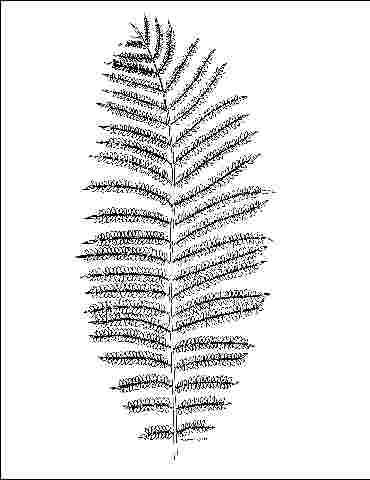Introduction
Soft, delicate, fernlike, deciduous foliage and dense terminal clusters of pure white, lightly fragrant, trumpet-shaped flowers make this large, spreading tree an outstanding specimen planting. The striking blooms can appear any time from April through August (most often May), and are sometimes present before the fresh, new, light green leaves appear in spring. Flowering is reportedly best following a winter with several nights in the upper 30's. Jacaranda may flower best when grown in poor soil. Jacarandas can reach 25 to 40 feet in height with an equal or greater spread, and the bent or arching trunks are covered with light grey bark.

Credit: UF/IFAS
General Information
Scientific name: Jacaranda mimosifolia
Pronunciation: jack-uh-RAN-duh mih-moe-sih-FOLE-ee-uh
Common name(s): 'Alba' jacaranda
Family: Bignoniaceae
USDA hardiness zones: 9B through 11 (Figure 2)
Origin: not native to North America
Invasive potential: not considered a problem species at this time, may be recommended (North, Central, South)
Uses: parking lot island 100–200 sq ft; parking lot island > 200 sq ft; street without sidewalk; tree lawn > 6 ft wide; shade; specimen

Credit: UF/IFAS
Description
Height: 25 to 40 feet
Spread: 45 to 60 feet
Crown uniformity: irregular
Crown shape: vase, spreading
Crown density: open
Growth rate: fast
Texture: fine
Foliage
Leaf arrangement: alternate (Figure 3)
Leaf type: bipinnately compound, odd-pinnately compound
Leaf margin: entire
Leaf shape: obovate, rhomboid
Leaf venation: unknown
Leaf type and persistence: deciduous
Leaf blade length: less than 2 inches
Leaf color: green
Fall color: no color change
Fall characteristic: not showy

Credit: UF/IFAS
Flower
Flower color: white/cream/gray
Flower characteristics: showy
Fruit
Fruit shape: irregular, pod or pod-like
Fruit length: 1 to 3 inches
Fruit covering: dry or hard
Fruit color: brown
Fruit characteristics: does not attract wildlife; not showy; fruit/leaves a litter problem
Trunk and Branches
Trunk/bark/branches: branches droop; showy; typically one trunk; thorns
Pruning requirement: needed for strong structure
Breakage: susceptible to breakage
Current year twig color: gray, brown
Current year twig thickness: thick
Wood specific gravity: unknown
Culture
Light requirement: full sun
Soil tolerances: sand; loam; clay; acidic; slightly alkaline; well-drained
Drought tolerance: high
Aerosol salt tolerance: none
Other
Roots: can form large surface roots
Winter interest: no
Outstanding tree: no
Ozone sensitivity: unknown
Verticillium wilt susceptibility: unknown
Pest resistance: resistant to pests/diseases
Use and Management
The light, dappled shade makes jacaranda well-suited for cooling patios, but it probably should not be used near pools due to the abundant leaf and flower drop. Jacaranda makes an ideal street tree, creating a spectacular sight when in full bloom. The arching branch habit is ideal for creating a canopy over a street or boulevard. Be sure to plant only those trees which have one central trunk and major limbs well-spaced apart for street tree and other high-use areas. Unpruned trees can become hazardous as they split apart at the crotches. Once properly trained and pruned, jacaranda is fairly strong-wooded and less messy than royal poinciana.
Small jacaranda trees can tolerate light shade and will grow quickly, but they will have the heaviest flowering when growing in full sun. They thrive in sandy, well-drained soils but should be watered during dry periods. Prune branches so they remain less than half the diameter of the trunk to help keep the plant intact and increase durability.
Propagation is by softwood cuttings or grafting. Seedlings often take a long time to bloom so grafted trees or those rooted from cuttings are preferred.
Pests
No pests are of major concern.
Diseases
Mushroom root rot is a problem on poorly-drained soil.
Literature Cited
University of Florida, Institute of Food and Agricultural Sciences. 2018. "Assessment of Non-native Plants in Florida's Natural Areas" (https://assessment.ifas.ufl.edu, 4/3/2024) Gainesville, FL, 32611-4000, USA.